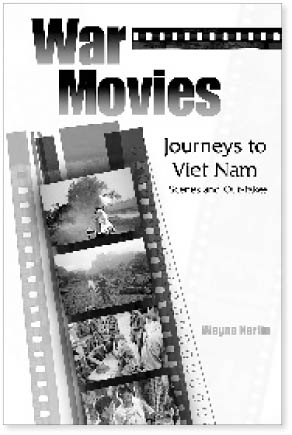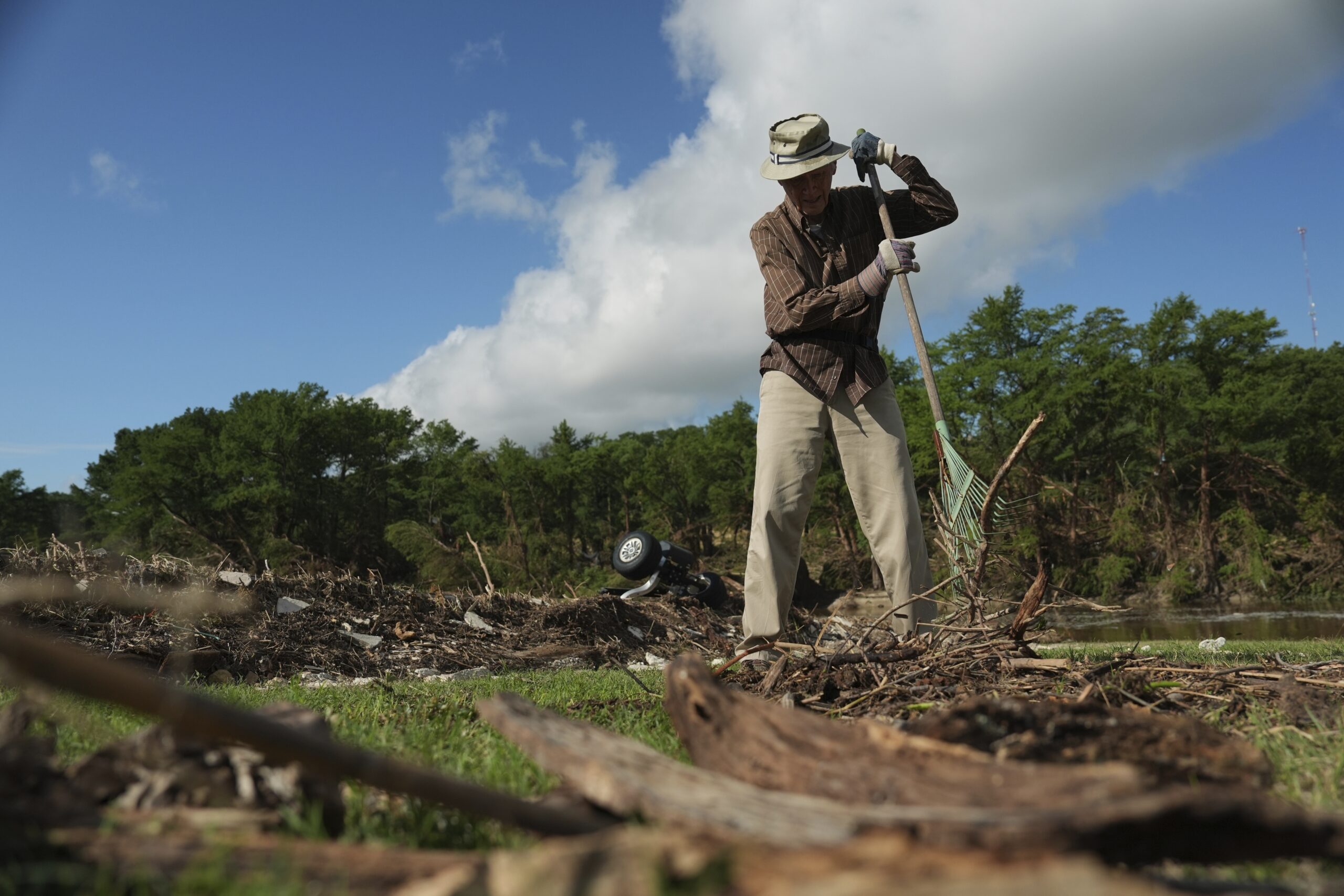Back to Vietnam
Back to Vietnam BY STEVEN G. KELLMAN War Movies: Journeys to Vietnam, Scenes and Out-takes By Wayne Karlin Curbstone Press 222 pages, $15.  ayne Karlin did not begin to question the justice of the Vietnam War until after he returned from fighting in it. During 1966-67, he served in the Marine Corps as a helicopter gunner based in Quang Nam and Quang Tri. Later, safely stateside, he read Jonathan Schell’s description, in The Military Half: An Account of Destruction in Quang Ngai and Quang Tin (1968), of how 80 percent of Quang Ngai province was obliterated and how an American officer justified the destruction of Ben Suc by insisting that was the only way to save it. Karlin was overcome with existential nausea. “I looked around myself in a crowded San Francisco park one day and saw all the people there as corpses draining into the earth, when I could see San Francisco as Hue,” he recalls. “It was the same, exactly the same, as the feeling of sexual betrayal, the knowledge that love could no longer be trusted, the crumbling of the foundations of the world.” Karlin’s subsequent career, as a writer, editor, translator, and professor, can be understood as an attempt to do for others what Schell did for him. Though Karlin did not return to Vietnam until 1994, in a sense he never left. Most of his 1996 memoir Rumors and Stones and his six published novels have put him back in country. In 1973, he co-edited the first anthology of fiction by American Vietnam veterans, Free Fire Zone. He also co-edited The Other Side of Heaven: Post-War Fiction by Vietnamese and American Writers (1995) as well as Love After War: Contemporary Fiction from Vietnam (2003) and helped translate Nguyen Khai’s Past Continuous (2001). A prominent figure in efforts at reconciliation between Vietnam and the United States, he writes that he often feels a closer kinship with veterans from Vietnam than with his own countrymen who did not share his violent ordeal.
ayne Karlin did not begin to question the justice of the Vietnam War until after he returned from fighting in it. During 1966-67, he served in the Marine Corps as a helicopter gunner based in Quang Nam and Quang Tri. Later, safely stateside, he read Jonathan Schell’s description, in The Military Half: An Account of Destruction in Quang Ngai and Quang Tin (1968), of how 80 percent of Quang Ngai province was obliterated and how an American officer justified the destruction of Ben Suc by insisting that was the only way to save it. Karlin was overcome with existential nausea. “I looked around myself in a crowded San Francisco park one day and saw all the people there as corpses draining into the earth, when I could see San Francisco as Hue,” he recalls. “It was the same, exactly the same, as the feeling of sexual betrayal, the knowledge that love could no longer be trusted, the crumbling of the foundations of the world.” Karlin’s subsequent career, as a writer, editor, translator, and professor, can be understood as an attempt to do for others what Schell did for him. Though Karlin did not return to Vietnam until 1994, in a sense he never left. Most of his 1996 memoir Rumors and Stones and his six published novels have put him back in country. In 1973, he co-edited the first anthology of fiction by American Vietnam veterans, Free Fire Zone. He also co-edited The Other Side of Heaven: Post-War Fiction by Vietnamese and American Writers (1995) as well as Love After War: Contemporary Fiction from Vietnam (2003) and helped translate Nguyen Khai’s Past Continuous (2001). A prominent figure in efforts at reconciliation between Vietnam and the United States, he writes that he often feels a closer kinship with veterans from Vietnam than with his own countrymen who did not share his violent ordeal.  A combination of memoir, travelogue, screenplay, fiction, and essay, War Movies returns Karlin to the scene of the war he left 38 years ago. Constructed in layers, the book in part recounts visits he made to Vietnam, in 2000 and 2004. During the former, he serves as a writer and advisor on the set of the first film made about the war by and with Vietnamese in Vietnam, Song of the Stork. The filmmakers, Nguyen Phan Quang Binh and Ngo Thi Bich Hanh, were born in the 1970s (Binh’s mother went into labor during Nixon’s Christmas 1972 bombing attack). Intent on avoiding movie cliches and cultural stereotypes, they count on Karlin to provide authentic details, especially about men in the American military. While creating a character, John, drawn loosely from his own service as a Marine in Vietnam, and revisiting sites he passed through during the war, Karlin summons up his own combat experiences. Thus, superimposed over an account of the making of Song of the Stork are Karlin’s actual memories of Vietnam as well as reminiscences by Vietnamese veterans he meets. Superimposed over all that is Karlin’s return to Vietnam in 2004, when he joins Israeli director Judd Ne’eman and his film students from New York University as they make a documentary about the reactions of a younger generation of Americans to the war that many of their fathers had fought in or protested against. Karlin’s own son, Adam, travels with him on this trip, during which he visits the scenes of some of the bloodiest events. As he did during his previous visit, Karlin again meets older Vietnamese who were his targets during helicopter runs and who would have killed him if they had had the chance. One of these is Do Quang Hanh, now a journalist for the newspaper Lao Dong. During the course of a dinner at a seafood restaurant in Hanoi, he quizzes Karlin: “It’s a year past the twenty-fifth anniversary of the end of the war. In this country we move on. Why do you keep writing about it? Are you so deeply affected? Or is it something you make up? After this much time, aren’t you putting yourself into an exaggerated spiritual crisis?” No one faults Virgil for writing about the Trojan War centuries after the sack of Troy. But Hanh’s questions haunt this book, as they must haunt Karlin through each of the thousands of pages he has written about a conflict that concluded with the fall of Saigon in 1975. He considers whether the choice of Vietnam as his specialty is literary opportunism, a macho topic designed to impress his students at the College of Southern Maryland and overcome the stigma of effeteness that Americans attach to authors. He notes that the answer might have become obvious a few years later, as the United States embarked on yet another military adventure and became “mired in a war that we’d gone into based on lies, self-deception, and willed ignorance of the history, culture, and politics of the region that we’d entered.” Parallels to Iraq are sufficient reason to continue pondering Vietnam and to hope for eventual reconciliation of the sort Karlin has been pursuing with former enemies in southeast Asia. But, invoking Henry James’s concept of art as “a human complication,” Karlin offers this as his aesthetic credo: “What keeps me writing about the war, thirty years after its end, is not that I was in it, but the ever-dimming and ever-brightening hope that rendering the complexities of human nature through the resonance of story might just be the direct opposite of that ultimate lack of imagination, that ultimate lack of empathy, that, simply, allows us to kill.” Karlin’s empathy is evident not only in his willingness to participate in the first film to portray the Vietnam War as the War Against the Americans, if not the Vietnam-American War; he worries that the determination by Binh and Hanh to tell stories that American movies leave out might not extend to telling stories that Vietnamese leave out. He visits a neighborhood in Hanoi where, during a single day in 1967, about 3,000 people were killed by B-52 bombers, devastation comparable to what befell a neighborhood in lower Manhattan on September 11, 2001. At Son My, the real name of the village usually known as My Lai, he challenges the NYU students to consider whether, as soldiers in Charley Company on March 16, 1968, they would have followed orders to massacre hundreds of villagers. Mindful how a sudden reassignment during his last three days in Vietnam spared him the fatal bullet that hit a fellow Marine, Karlin grieves over the 50,000 American lives lost in southeast Asia. But he also mourns the 3 million Vietnamese, from both sides, who died during the conflict. Karlin includes a fictionalized account of a Marine gunner’s anxious efforts to provide cover during a medevac operation. But some of his most vivid writing is found in short narratives that portray Vietnamese as independent moral agents, not just human targets. In one, he tells the story of a six-year-old girl named Lanh whose parents send her to the countryside when the bombing of Hanoi becomes most intense. When they eventually come to visit her, Lanh’s mother and father are both immediately killed in a freak attack, and the child returns alone to haunt the streets of Hanoi. Another story recounts the prodigious career of a sniper named Son who collects various body parts from his American victims, including a soldier who is in the act of making love to a Vietnamese woman when Son sneaks up and slits his throat. Karlin calls these vignettes “out-takes,” as if movies were the model for giving form to war. Among a group of Russian extras hired to play American soldiers in Song of the Stork, one seems incapable of speaking to Karlin except by echoing lines from American films about Vietnam—Hamburger Hill, Rambo, Full Metal Jacket. Not only is Karlin’s book, called War Movies, in part a novelization of the Vietnamese film that he worked on (shortly before the crew of The Quiet American arrived to use the same sites) as well as an account of the making of the NYU documentary, but it is itself saturated with cinematic references. Part of Karlin’s eagerness to make a film, as well as a book with the flashbacks and crosscuts that mimic the other medium, is that he shares the widespread belief that, “Nothing was real until it was a movie.” Overlap dissolve is the cinematic technique most evident in a book that is a palimpsest of movies superimposed on memories superimposed on stories superimposed on memories, ad confusionem. One of the central characters in Song of the Stork, a Vietnamese filmmaker named Vinh who goes into combat to document the war, is based on a Vietnamese filmmaker, Tran Van Thuy, who went into combat to document the war. Back in Vietnam, Karlin, mixing memory and movies, feels, “as if I am experiencing everything through a series of lenses whose edges overlap and blur what they frame into each other.” He has produced an untidy package of fiction and nonfiction that aspires to the moral ambiguities he finds missing from most talk about war. A film about what happened in Vietnam, says Karlin, requires chaos. It “needs to touch the contradictory complexity which is the breath of truth.” War Movies emits that stench. Steven G. Kellman teaches comparative literature at the University of Texas at San Antonio.
A combination of memoir, travelogue, screenplay, fiction, and essay, War Movies returns Karlin to the scene of the war he left 38 years ago. Constructed in layers, the book in part recounts visits he made to Vietnam, in 2000 and 2004. During the former, he serves as a writer and advisor on the set of the first film made about the war by and with Vietnamese in Vietnam, Song of the Stork. The filmmakers, Nguyen Phan Quang Binh and Ngo Thi Bich Hanh, were born in the 1970s (Binh’s mother went into labor during Nixon’s Christmas 1972 bombing attack). Intent on avoiding movie cliches and cultural stereotypes, they count on Karlin to provide authentic details, especially about men in the American military. While creating a character, John, drawn loosely from his own service as a Marine in Vietnam, and revisiting sites he passed through during the war, Karlin summons up his own combat experiences. Thus, superimposed over an account of the making of Song of the Stork are Karlin’s actual memories of Vietnam as well as reminiscences by Vietnamese veterans he meets. Superimposed over all that is Karlin’s return to Vietnam in 2004, when he joins Israeli director Judd Ne’eman and his film students from New York University as they make a documentary about the reactions of a younger generation of Americans to the war that many of their fathers had fought in or protested against. Karlin’s own son, Adam, travels with him on this trip, during which he visits the scenes of some of the bloodiest events. As he did during his previous visit, Karlin again meets older Vietnamese who were his targets during helicopter runs and who would have killed him if they had had the chance. One of these is Do Quang Hanh, now a journalist for the newspaper Lao Dong. During the course of a dinner at a seafood restaurant in Hanoi, he quizzes Karlin: “It’s a year past the twenty-fifth anniversary of the end of the war. In this country we move on. Why do you keep writing about it? Are you so deeply affected? Or is it something you make up? After this much time, aren’t you putting yourself into an exaggerated spiritual crisis?” No one faults Virgil for writing about the Trojan War centuries after the sack of Troy. But Hanh’s questions haunt this book, as they must haunt Karlin through each of the thousands of pages he has written about a conflict that concluded with the fall of Saigon in 1975. He considers whether the choice of Vietnam as his specialty is literary opportunism, a macho topic designed to impress his students at the College of Southern Maryland and overcome the stigma of effeteness that Americans attach to authors. He notes that the answer might have become obvious a few years later, as the United States embarked on yet another military adventure and became “mired in a war that we’d gone into based on lies, self-deception, and willed ignorance of the history, culture, and politics of the region that we’d entered.” Parallels to Iraq are sufficient reason to continue pondering Vietnam and to hope for eventual reconciliation of the sort Karlin has been pursuing with former enemies in southeast Asia. But, invoking Henry James’s concept of art as “a human complication,” Karlin offers this as his aesthetic credo: “What keeps me writing about the war, thirty years after its end, is not that I was in it, but the ever-dimming and ever-brightening hope that rendering the complexities of human nature through the resonance of story might just be the direct opposite of that ultimate lack of imagination, that ultimate lack of empathy, that, simply, allows us to kill.” Karlin’s empathy is evident not only in his willingness to participate in the first film to portray the Vietnam War as the War Against the Americans, if not the Vietnam-American War; he worries that the determination by Binh and Hanh to tell stories that American movies leave out might not extend to telling stories that Vietnamese leave out. He visits a neighborhood in Hanoi where, during a single day in 1967, about 3,000 people were killed by B-52 bombers, devastation comparable to what befell a neighborhood in lower Manhattan on September 11, 2001. At Son My, the real name of the village usually known as My Lai, he challenges the NYU students to consider whether, as soldiers in Charley Company on March 16, 1968, they would have followed orders to massacre hundreds of villagers. Mindful how a sudden reassignment during his last three days in Vietnam spared him the fatal bullet that hit a fellow Marine, Karlin grieves over the 50,000 American lives lost in southeast Asia. But he also mourns the 3 million Vietnamese, from both sides, who died during the conflict. Karlin includes a fictionalized account of a Marine gunner’s anxious efforts to provide cover during a medevac operation. But some of his most vivid writing is found in short narratives that portray Vietnamese as independent moral agents, not just human targets. In one, he tells the story of a six-year-old girl named Lanh whose parents send her to the countryside when the bombing of Hanoi becomes most intense. When they eventually come to visit her, Lanh’s mother and father are both immediately killed in a freak attack, and the child returns alone to haunt the streets of Hanoi. Another story recounts the prodigious career of a sniper named Son who collects various body parts from his American victims, including a soldier who is in the act of making love to a Vietnamese woman when Son sneaks up and slits his throat. Karlin calls these vignettes “out-takes,” as if movies were the model for giving form to war. Among a group of Russian extras hired to play American soldiers in Song of the Stork, one seems incapable of speaking to Karlin except by echoing lines from American films about Vietnam—Hamburger Hill, Rambo, Full Metal Jacket. Not only is Karlin’s book, called War Movies, in part a novelization of the Vietnamese film that he worked on (shortly before the crew of The Quiet American arrived to use the same sites) as well as an account of the making of the NYU documentary, but it is itself saturated with cinematic references. Part of Karlin’s eagerness to make a film, as well as a book with the flashbacks and crosscuts that mimic the other medium, is that he shares the widespread belief that, “Nothing was real until it was a movie.” Overlap dissolve is the cinematic technique most evident in a book that is a palimpsest of movies superimposed on memories superimposed on stories superimposed on memories, ad confusionem. One of the central characters in Song of the Stork, a Vietnamese filmmaker named Vinh who goes into combat to document the war, is based on a Vietnamese filmmaker, Tran Van Thuy, who went into combat to document the war. Back in Vietnam, Karlin, mixing memory and movies, feels, “as if I am experiencing everything through a series of lenses whose edges overlap and blur what they frame into each other.” He has produced an untidy package of fiction and nonfiction that aspires to the moral ambiguities he finds missing from most talk about war. A film about what happened in Vietnam, says Karlin, requires chaos. It “needs to touch the contradictory complexity which is the breath of truth.” War Movies emits that stench. Steven G. Kellman teaches comparative literature at the University of Texas at San Antonio.


